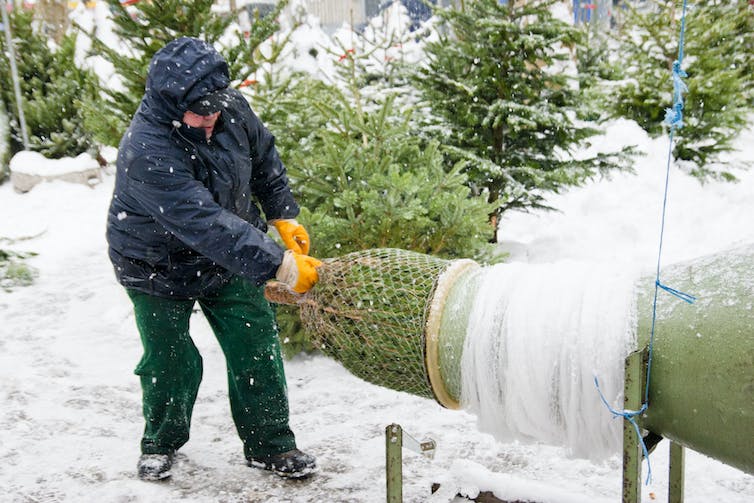Every year somewhere between 25 million and 30 million Christmas trees are sold in the United States. If you’re one of the people who decorate for the holiday with a freshly cut Christmas tree, you might be wondering how to keep it looking good all the way through Santa’s visit – and maybe even a little beyond.
Curtis VanderSchaaf is a forestry specialist at the Mississippi State University Extension Service who knows a thing or two about conifers. The Conversation U.S. asked him for guidance on how to keep a fresh green Christmas tree from becoming a giant pile of brown needles, for as long as possible. Whether you end up with a Douglas fir, a Scotch pine, a Leyland cypress, a piñon or any other evergreen, he says the quality of care you provide is a major factor in the prolonged freshness of your tree.
What to consider when choosing a tree
Select a tree that looks fresh and whose needles are not brittle. You want one that has a strong fragrance and a dark natural green color. Avoid bored holes in the wood, signs of bugs – like spider egg sacs – and other marks of pest damage. This advice holds whether you’re chopping down your own tree or buying it from a retailer.
Different species of trees have various colors, shapes, branching habits, needle types, scent and even bark type. Depending on what’s available to you, this comes down to personal preference.
If you can, pick a tree that’s been harvested as recently as possible and been watered and kept cool. Often a tree’s freshness is directly related to the moisture content of its needles. If the stump – where the tree’s trunk was cut – is sticky with sap, that’s a good sign.
Give the tree a good shake, even a hard pound on the ground. That will dislodge any animal stowaways. If a ton of dead needles or dry limbs fall out, keep looking.

Netting the tree makes it easier to transport and helps prevent damage to the branches.
Wicki58/iStock via Getty Images Plus
Getting your tree home
Tree farms and retail lots will net your tree. It’s a lot easier to transport with the branches tucked in. If you’re going to bring it home on top of your car, consider using a tarp to keep scratches and sap off your vehicle. Make sure the tree is securely tied down, with the trunk facing forward to reduce wind damage to the branches. Take it easy on the road.
If you’re not bringing your tree indoors right away, store it in a cool, damp area that is blocked from wind and out of the sun.
Make a fresh, straight-across cut on the butt of the tree about a half-inch to 1 inch (1 to 3 centimeters) above the original cut. After any cut, a tree tries immediately to seal off, or compartmentalize, the injury, which makes it hard for the tree to take up water. So as soon as you make the new cut, place the tree in a bucket of warm water. Make sure it stays full as the tree drinks.
If you have allergies, you may want to spray the tree with a…



